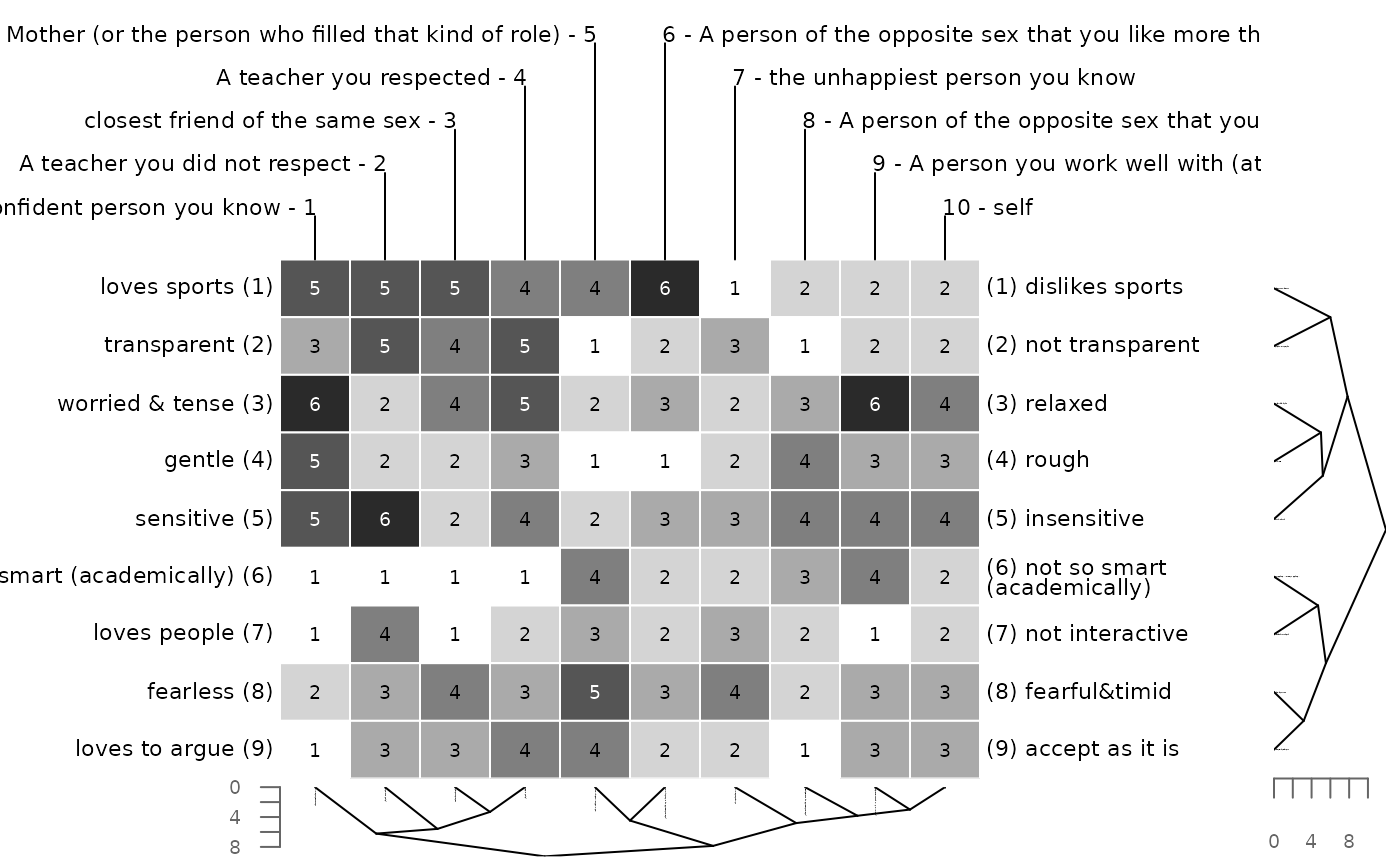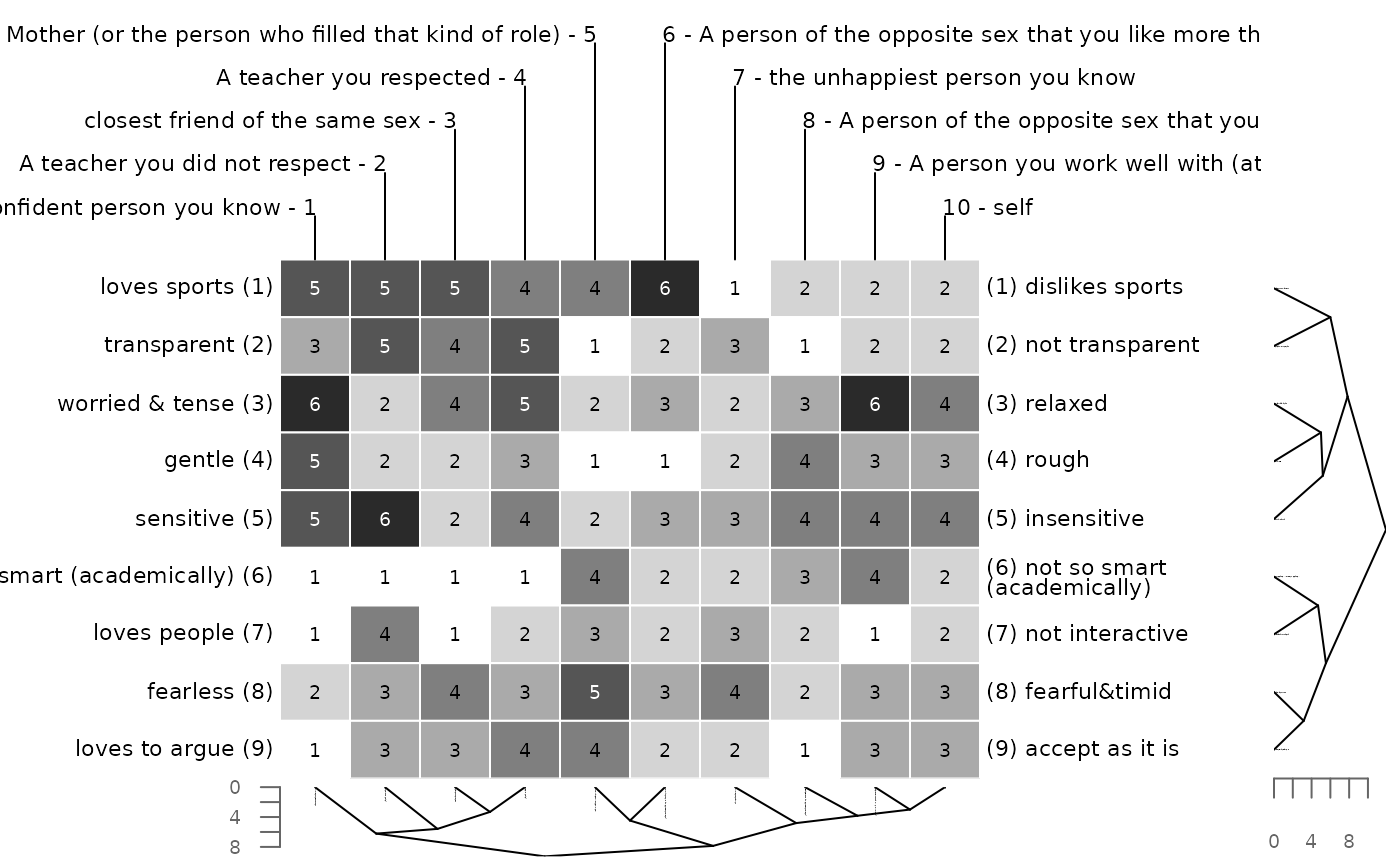Description
A method for identifying structures in construct system is cluster analysis. Any distance or similarity measure accounting for a certain type of association could be used as a cluster criterion. Traditionally mostly Euclidean and Manhattan distances have been used. The earliest implementation of a cluster algorithm for repertory grids was incorporated in the program FOCUS (Shaw & Thomas, 1978).
Several distance measure can be selected (explanations from
?dist dcoumentation):
-
euclidean: Squared distance between the two vectors (L2 norm) -
manhattan: Also called city-block-distance, absolute distance between the two vectors (L1 norm). -
minkowski: The p norm, the pth root of the sum of the pth powers of the differences of the components. -
maximum: Maximum distance between two components of x and y (supremum norm) -
canberra: Terms with zero numerator and denominator are omitted from the sum and treated as if the values were missing. This is intended for non-negative values (e.g. counts). -
binary: The vectors are regarded as binary bits, so non-zero elements are on and zero elements are off. The distance is the proportion of bits in which only one is on amongst those in which at least one is on.
Also several cluster methods can be selected (explanations from ?hclust documentation).
-
ward.D,ward.D2: Ward’s minimum variance method aims at finding compact, spherical clusters. -
complete: The complete linkage method finds similar clusters. -
single: The single linkage method (which is closely related to the minimal spanning tree) adopts a ‘friends of friends’ clustering strategy.
The other methods can be regarded as aiming for clusters with characteristics somewhere between the single and complete link methods:
averagemcquittymediancentroid
The distance and cluster methods can be combined as wished.
R-Code
Clustering
When the function cluster is called dendrograms of the
construct and element clustering are drawn.
cluster(bell2010)
The function also returns the reordered matrix invisibly. To see the
reordered grid save it into a new object. To oppress the creation of a
graphic set print = FALSE.
x <- cluster(bell2010, print = FALSE)
x
#
# RATINGS:
# Mother (or the person who fill - 5 6 - A person of the opposite sex t
# A teacher you respected - 4 | | 7 - the unhappiest person you kn
# sest friend of the same sex - 3 | | | | 8 - A person of the opposite s
# acher you did not respect - 2 | | | | | | 9 - A person you work well w
# t confident person you - 1 | | | | | | | | 10 - self
# | | | | | | | | | |
# loves sports (.1) 5 5 5 4 4 6 1 2 2 2 (1.) dislikes sports
# transparent (.2) 3 5 4 5 1 2 3 1 2 2 (2.) not transparent
# worried & tense (.3) 6 2 4 5 2 3 2 3 6 4 (3.) relaxed
# gentle (.4) 5 2 2 3 1 1 2 4 3 3 (4.) rough
# sensitive (.5) 5 6 2 4 2 3 3 4 4 4 (5.) insensitive
# art (academically) (.6) 1 1 1 1 4 2 2 3 4 2 (6.) not so smart (aca
# loves people (.7) 1 4 1 2 3 2 3 2 1 2 (7.) not interactive
# fearless (.8) 2 3 4 3 5 3 4 2 3 3 (8.) fearful&timid
# loves to argue (.9) 1 3 3 4 4 2 2 1 3 3 (9.) accept as it is
#
# Poles: (+) = preferred , (-) = non-preferred , (/) = none , (.) = not definedThe function also allows to only cluster constructs or elements. To only cluster the constructs us the following code. Again a dendrogram is drawn and a grid with reordered constructs is returned.
x <- cluster(bell2010, along = 1, print = FALSE)
x
#
# RATINGS:
# Mother (or the person who fill - 5 6 - A person of the opposite sex t
# A teacher you respected - 4 | | 7 - the unhappiest person you kn
# sest friend of the same sex - 3 | | | | 8 - A person you work well wit
# acher you did not respect - 2 | | | | | | 9 - self
# t confident person you - 1 | | | | | | | | 10 - A person of the oppos
# | | | | | | | | | |
# loves sports (.1) 5 5 5 4 4 6 1 2 2 2 (1.) dislikes sports
# transparent (.2) 3 5 4 5 1 2 3 2 2 1 (2.) not transparent
# worried & tense (.3) 6 2 4 5 2 3 2 6 4 3 (3.) relaxed
# gentle (.4) 5 2 2 3 1 1 2 3 3 4 (4.) rough
# sensitive (.5) 5 6 2 4 2 3 3 4 4 4 (5.) insensitive
# art (academically) (.6) 1 1 1 1 4 2 2 4 2 3 (6.) not so smart (aca
# loves people (.7) 1 4 1 2 3 2 3 1 2 2 (7.) not interactive
# fearless (.8) 2 3 4 3 5 3 4 3 3 2 (8.) fearful&timid
# loves to argue (.9) 1 3 3 4 4 2 2 3 3 1 (9.) accept as it is
#
# Poles: (+) = preferred , (-) = non-preferred , (/) = none , (.) = not definedTo only cluster the elements set along=2.
x <- cluster(bell2010, along = 2, print = FALSE)
x
#
# RATINGS:
# Mother (or the person who fill - 5 6 - A person of the opposite sex t
# A teacher you respected - 4 | | 7 - the unhappiest person you kn
# sest friend of the same sex - 3 | | | | 8 - A person of the opposite s
# acher you did not respect - 2 | | | | | | 9 - A person you work well w
# t confident person you - 1 | | | | | | | | 10 - self
# | | | | | | | | | |
# transparent (.1) 3 5 4 5 1 2 3 1 2 2 (1.) not transparent
# loves sports (.2) 5 5 5 4 4 6 1 2 2 2 (2.) dislikes sports
# gentle (.3) 5 2 2 3 1 1 2 4 3 3 (3.) rough
# worried & tense (.4) 6 2 4 5 2 3 2 3 6 4 (4.) relaxed
# sensitive (.5) 5 6 2 4 2 3 3 4 4 4 (5.) insensitive
# loves people (.6) 1 4 1 2 3 2 3 2 1 2 (6.) not interactive
# art (academically) (.7) 1 1 1 1 4 2 2 3 4 2 (7.) not so smart (aca
# loves to argue (.8) 1 3 3 4 4 2 2 1 3 3 (8.) accept as it is
# fearless (.9) 2 3 4 3 5 3 4 2 3 3 (9.) fearful&timid
#
# Poles: (+) = preferred , (-) = non-preferred , (/) = none , (.) = not definedTo apply different distance measures and cluster methods us the
arguments dmethod and cmethod (here
manhattan distance and single linkage
clustering).
x <- cluster(bell2010, dmethod = "manh", cmethod = "single", print = FALSE)
x
#
# RATINGS:
# the unhappiest person you know - 5 6 - A person of the opposite sex t
# losest friend of the same sex - 4 | | 7 - A teacher you respected
# teacher you did not respect - 3 | | | | 8 - A person of the opposite s
# ost confident person you - 2 | | | | | | 9 - self
# (or the person who fill - 1 | | | | | | | | 10 - A person you work wel
# | | | | | | | | | |
# art (academically) (.1) 4 7 7 7 6 6 7 5 6 4 (1.) smart (academical
# not interactive (.2) 5 7 4 7 5 6 6 6 6 7 (2.) loves people
# fearful&timid (.3) 3 6 5 4 4 5 5 6 5 5 (3.) fearless
# accept as it is (.4) 4 7 5 5 6 6 4 7 5 5 (4.) loves to argue
# not transparent (.5) 7 5 3 4 5 6 3 7 6 6 (5.) transparent
# sensitive (.6) 2 5 6 2 3 3 4 4 4 4 (6.) insensitive
# gentle (.7) 1 5 2 2 2 1 3 4 3 3 (7.) rough
# worried & tense (.8) 2 6 2 4 2 3 5 3 4 6 (8.) relaxed
# dislikes sports (.9) 4 3 3 3 7 2 4 6 6 6 (9.) loves sports
#
# Poles: (+) = preferred , (-) = non-preferred , (/) = none , (.) = not definedTo apply different methods to the constructs and the rows, use a two-step approach.
# cluster constructs using default methods
x <- cluster(bell2010, along = 1, print = FALSE)
# cluster elements using manhattan distance and single linkage clustering
x <- cluster(x, along = 2, dm = "manh", cm = "single", print = FALSE)
x
#
# RATINGS:
# A person of the opposite sex t - 5 6 - the unhappiest person you know
# losest friend of the same sex - 4 | | 7 - A teacher you respected
# teacher you did not respect - 3 | | | | 8 - A person of the opposite s
# r (or the person who fill - 2 | | | | | | 9 - A person you work well w
# t confident person you - 1 | | | | | | | | 10 - self
# | | | | | | | | | |
# insensitive (.1) 3 6 2 6 5 5 4 4 4 4 (1.) sensitive
# rough (.2) 3 7 6 6 7 6 5 4 5 5 (2.) gentle
# relaxed (.3) 2 6 6 4 5 6 3 5 2 4 (3.) worried & tense
# loves people (.4) 1 3 4 1 2 3 2 2 1 2 (4.) not interactive
# art (academically) (.5) 1 4 1 1 2 2 1 3 4 2 (5.) not so smart (aca
# loves to argue (.6) 1 4 3 3 2 2 4 1 3 3 (6.) accept as it is
# fearless (.7) 2 5 3 4 3 4 3 2 3 3 (7.) fearful&timid
# transparent (.8) 3 1 5 4 2 3 5 1 2 2 (8.) not transparent
# loves sports (.9) 5 4 5 5 6 1 4 2 2 2 (9.) dislikes sports
#
# Poles: (+) = preferred , (-) = non-preferred , (/) = none , (.) = not definedSome other options can be set. Paste the code into the R console to
try it out. See ?cluster for more information.
cluster(bell2010, main = "My cluster analysis") # new title
cluster(bell2010, type = "t") # different drawing style
cluster(bell2010, dmethod = "manhattan") # using manhattan metric
cluster(bell2010, cmethod = "single") # do single linkage clustering
cluster(bell2010, cex = 1, lab.cex = 1) # change appearance
cluster(bell2010,
lab.cex = .7, # advanced appearance changes
edgePar = list(lty = 1:2, col = 2:1)
)Clustered Bertin
The following figure shows a clustered Bertin matrix. The full explanation is found under the section Bertin display.
bertinCluster(bell2010)

